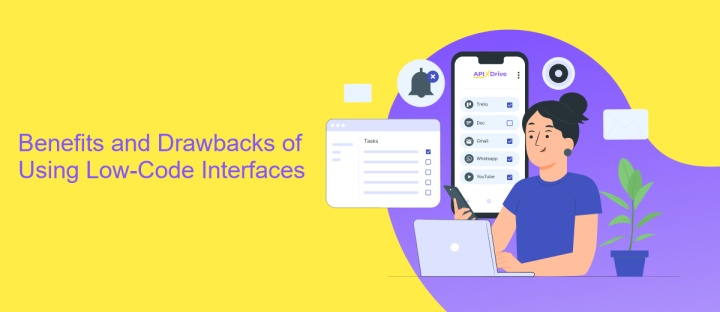Low-Code Interface
The rise of low-code interfaces is transforming the landscape of software development, enabling users with minimal coding expertise to create robust applications efficiently. By leveraging intuitive drag-and-drop tools and pre-built templates, low-code platforms empower businesses to accelerate their digital transformation efforts. This approach not only reduces development time and costs but also fosters innovation by allowing more stakeholders to participate in the app creation process.
Introduction to Low-Code Interfaces
Low-code interfaces have emerged as a revolutionary approach in software development, allowing users with minimal programming knowledge to create applications efficiently. These platforms provide a visual development environment, enabling businesses to streamline their processes and reduce the time-to-market for their products. By minimizing the need for extensive coding, low-code interfaces democratize application development, making it accessible to a broader range of individuals and organizations.
- Accelerated development cycles: Applications can be built rapidly, reducing the time required for deployment.
- Cost efficiency: Lower development costs as fewer specialized developers are needed.
- Enhanced collaboration: Business and IT teams can work together seamlessly, fostering innovation.
The rise of low-code platforms signifies a shift towards more agile and flexible development methodologies. As businesses face increasing pressure to innovate and adapt quickly, low-code interfaces offer a viable solution to meet these demands. By empowering a wider audience to participate in the development process, these platforms not only enhance productivity but also drive digital transformation across industries. As technology continues to evolve, the role of low-code solutions is expected to grow, shaping the future of application development.
Benefits and Drawbacks of Using Low-Code Interfaces

Low-code interfaces offer a range of benefits, making them increasingly popular among businesses seeking to streamline their development processes. One of the most significant advantages is the ability to accelerate application development. By minimizing the need for extensive coding, low-code platforms empower users with limited technical expertise to create functional applications quickly. This democratization of development can lead to increased innovation and flexibility within organizations. Additionally, low-code platforms often integrate seamlessly with existing systems and services, such as ApiX-Drive, which simplifies the process of setting up integrations and automating workflows, further enhancing operational efficiency.
However, low-code interfaces are not without their drawbacks. While they provide speed and accessibility, they may also lead to limitations in customization. Applications built on low-code platforms can sometimes lack the depth and specificity required for complex, unique business needs, potentially necessitating additional custom development. Moreover, reliance on a particular platform can result in vendor lock-in, where businesses become dependent on a single provider's ecosystem. Additionally, while low-code solutions reduce the need for extensive coding, they still require a foundational understanding of application logic, which can be a barrier for some users. Balancing these benefits and drawbacks is essential for organizations considering the adoption of low-code interfaces.
Key Features and Functionality of Low-Code Interfaces

Low-code interfaces are revolutionizing the way applications are developed by providing a simplified platform that minimizes the need for extensive coding. These platforms empower users, including those with minimal technical expertise, to create applications efficiently. By providing a visual development environment, low-code interfaces streamline the application development process and significantly reduce time-to-market.
- Drag-and-Drop Functionality: Users can easily select and place elements to design applications without writing complex code.
- Pre-built Templates: These templates offer a variety of ready-to-use components that accelerate the development process.
- Integration Capabilities: Low-code platforms support seamless integration with existing systems and third-party services.
- Automated Workflows: Users can automate processes, reducing manual tasks and enhancing productivity.
- Scalability: The platforms are designed to grow with the organization’s needs, accommodating increased demand effortlessly.
By offering these features, low-code interfaces democratize application development, enabling organizations to innovate rapidly and adapt to changing market demands. They not only enhance the efficiency of professional developers but also empower non-developers to contribute to digital transformation initiatives. As a result, businesses can focus on strategic goals while leveraging technology to drive growth and competitiveness.
Use Cases and Applications of Low-Code Interfaces

Low-code interfaces are revolutionizing the way businesses approach software development by enabling rapid application creation with minimal hand-coding. These platforms are particularly beneficial for organizations looking to accelerate digital transformation and enhance operational efficiency. By reducing the dependency on traditional coding, low-code interfaces empower non-technical users to participate in the development process, fostering innovation and collaboration.
One of the primary use cases for low-code interfaces is in the development of internal business applications. These platforms allow companies to quickly build custom solutions tailored to their specific needs without the extensive time and cost associated with traditional development methods. Additionally, low-code interfaces are instrumental in automating workflows, streamlining processes, and integrating disparate systems.
- Rapid prototyping and MVP development
- Automating repetitive tasks and workflows
- Creating customer-facing applications
- Integrating with existing systems and databases
- Enabling citizen development for non-technical staff
As businesses continue to seek agility and efficiency, the adoption of low-code interfaces is expected to grow. These platforms not only reduce development time and costs but also enhance flexibility, allowing organizations to adapt quickly to changing market demands. Ultimately, low-code interfaces are paving the way for a more inclusive and dynamic approach to software development.


Future Trends and Development of Low-Code Interfaces
The future of low-code interfaces is set to be transformative, driven by the increasing demand for rapid application development and digital transformation. As businesses strive to become more agile, low-code platforms will continue to evolve, offering more sophisticated tools that empower users with little to no coding experience. These platforms will integrate advanced technologies like artificial intelligence and machine learning, enabling more intuitive and intelligent interface designs. This evolution will democratize software development further, allowing even non-technical users to create complex applications, thus bridging the gap between business needs and IT capabilities.
Integration capabilities will also play a crucial role in the development of low-code interfaces. Services like ApiX-Drive will become essential, providing seamless connectivity between disparate systems and applications. This will enable businesses to automate workflows and enhance operational efficiency without the need for extensive coding knowledge. As the ecosystem of low-code tools expands, we can expect a rise in community-driven innovation, where shared templates and modules accelerate development processes. Ultimately, low-code interfaces will not only reshape how applications are built but also how businesses operate in an increasingly digital world.
FAQ
What is a Low-Code Interface?
How does a Low-Code Interface benefit businesses?
Can Low-Code Interfaces be used for automation and integration?
Are Low-Code Interfaces secure?
What types of applications can be built with a Low-Code Interface?
Time is the most valuable resource in today's business realities. By eliminating the routine from work processes, you will get more opportunities to implement the most daring plans and ideas. Choose – you can continue to waste time, money and nerves on inefficient solutions, or you can use ApiX-Drive, automating work processes and achieving results with minimal investment of money, effort and human resources.

